9 Common Ways Workplace Injuries Occur And How to Avoid Them
Injuries at work are a big threat that inflicts on the lives of workers and profits of companies all over the world. This shows that more care, in general, has to be taken by the workers and their employers, and these things must be stopped before they start. Knowing the way most people usually get hurt helps a lot because bosses and workers can look out for trouble ahead of time, and this piece will show you exactly how these injuries happen.

1. Slips And Falls
These are among the biggest contributors to most workplace injuries. They are derived from things like wet floors, bumpy ground, and dark spots. These accidents mostly arise from simple risks like spilled liquids or cluttered walkways. To minimize the occurrence of these bad events, keep the floors cleaned and dry, ensure the pathways are clear, and even make places brighter if possible. In addition, giving workers shoes that grip well can help them a lot. It will make it less likely for them to fall and get hurt.
2. Overexertion
Another major reason for getting hurt at work is working too hard. In most cases, this comes when workers do heavy jobs like lifting, pushing, pulling, or moving heavy items. Ideally, these actions may hurt muscles and cause sprains or strains. Employers and employees should be aware that there are rules and laws governing overexertion. To avoid these hurts, employers should purchase items that will be able to fit the workers and help them work better, like forklifts and dollies. Moreover, they should also train the workers on the way to lift. Besides, constant relaxation and stretching of the working muscles would most likely lead to stronger bodies and minimization of injury cases.
When injured at work, seeking legal help is vital in many ways. In the words of Carrollton Workers' Compensation Attorneys, it will help you get the right compensation for medical bills and lost wages. Lawyers will handle everything from paperwork to negotiations and, if needed, court cases. With their support, you can focus on healing while knowing your rights are protected.
3. Contact With Objects And Equipment
It's common to get hurt by things or machines at work. This ranges from small cuts and knocks to worse injuries. Employers have to keep the machines working right with the help of professional maintenance or assessment to avoid those sorts of troubles. However, if an employer provides the employees with gear that can help them take proper care of themselves, like gloves or goggles, it will prevent them from getting minor injuries. Teaching workers how to always be safe makes everybody watch for danger. By doing these things, bosses can keep their workers safe from getting hurt by things or machines.
4. Repetitive Motion Injuries
Repetitive motion injuries, such as carpal tunnel syndrome or tendonitis, get worse very slowly. Job rotation helps prevent these injuries from worsening. Teaching better sitting and stretching stops these specific places of the body from hurting too much. It is very important for employers to also provide breaks and tools that help reduce the impact of manual labor. These short breaks let workers rest and get their energy back.
5. Workplace Violence
Workplace violence can vary from the different aspects, from fellow employers and bosses, or vice versa. They can range from mean words to unfair treatment and physical hitting. And further, acts of this workplace violence can do real harm to employees' bodies and minds. Employers must be able to recognize and minimize such destructive behaviors by letting employees know that malpractice will not be tolerated. In addition, they should put a list of consequences and make it known to all old and new employees. And provide improved training on how to stay unified, resolve conflicts, and use de-escalation techniques.
6. Struck By Or Against Objects
Almost half of workplace accidents are brought about by workers getting hit or bumping into distinct things within a workplace. However, employers could stop such mishaps by implementing key safety measures. For example, they can ensure that all heavy items are well-held and marked, thus averting surprise knocks. Moreover, they can ascertain that myriad warning signs exist in dangerous spots that warn workers of the danger.
7. Vehicle Accidents
These levels of accidents can be a big danger, especially in the transportation business. While some accidents are inevitable, others could have been avoided if the driver had not been speeding, been more attentive, or received adequate training. Business managers must make clear rules in regard to automobile driving. They should also prioritize good training on handling the vehicles and taking caution of the dangers lurking along the roads. Further, working vehicles have to be routinely checked and repaired.
8. Falls From Heights
Falls from great heights, including roofs and raised platforms, are highly risky for employees. The employer is required to follow safety measures in order to avoid any dangerous circumstances. These include giving out the right equipment to stop falls, such as belts and side rails, and looking for risks before starting high-up work. In this regard, this would help identify hazards in a timely manner before they become critical. They should also ensure that the workways are safe by properly using ladders or frames. With that in place, few accidents can be recorded.
Chemical Exposure

Harmful exposure to hazardous chemicals in the workplace could range from problems in breathing to skin burns and getting sick in the long run, for example, cancer. In this regard, preventing such injuries from taking place is vitally essential to reduce these risks. This means issuing the right gear to keep workers safe from bad chemicals. Personal protective equipment includes gas masks, gloves, and respirators; these can do a world of good to workers. Furthermore, great care is supposed to be taken in the handling, storage, and disposal of these chemicals to reduce the possibility of skin contact or inhaling their gasses.
Understanding how damages take place at the workplace is central to a secure and sound workplace. Going for the possible risk and trying to prevent it, employers and employees may make the work area safer, and in such a situation, the number of accidents and injuries would be reduced. Furthermore, the priority of safety is not only that the workers are not getting hurt but also to maintain work and feelings, which helps businesses do well.